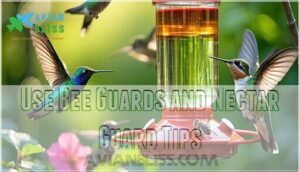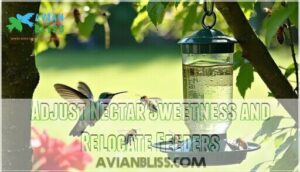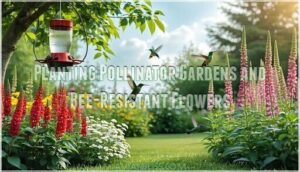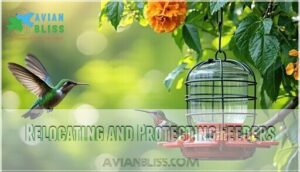This site is supported by our readers. We may earn a commission, at no cost to you, if you purchase through links.

Choose red feeders without yellow accents since bees are naturally attracted to yellow, and maintain pristine cleanliness to eliminate sticky spills that draw insects.
Position your feeders in shaded areas where bees are less active, and consider using natural deterrents like diluted vinegar solutions around the feeder base.
Strategic placement combined with proper maintenance creates an environment that welcomes hummingbirds while discouraging their buzzing competitors, using methods such as natural deterrents and maintaining a clean feeder to ensure easy access for the birds.
Table Of Contents
- Key Takeaways
- Hummingbird Feeder Selection
- Keep Bees Away From Feeders
- Feeder Maintenance and Cleaning
- Natural Bee Repellents and Deterrents
- Relocating and Protecting Feeders
- Frequently Asked Questions (FAQs)
- How do I stop bees around my hummingbird feeder?
- Why put aluminum foil around a hummingbird feeder?
- Does Vicks keep bees away?
- How do I protect my hummingbird feeder?
- Can you keep bees off hummingbird feeders?
- How to keep hummingbirds away from a feeder?
- How do you keep bees away from a bird feeder?
- Do bees eat yellow hummingbird feeders?
- What repels bees but not hummingbirds?
- How do I make my hummingbird feeder bee proof?
- Conclusion
Key Takeaways
- Choose saucer-style feeders with bee guards – You’ll prevent bees from accessing nectar by using dish feeders that position nectar below feeding ports, making it impossible for bees’ short tongues to reach the sugar water while hummingbirds can still feed easily.
- Select red feeders without yellow accents – You’ll reduce bee attraction by avoiding yellow colors that signal food sources to bees, while red feeders naturally attract hummingbirds without drawing unwanted buzzing visitors.
- Maintain clean feeders and fix leaks immediately – You’ll eliminate the sticky spills and sugar residue that turn your feeder into a bee magnet by tightening ports, cleaning regularly, and wiping up any nectar drips around the feeding area.
- Use strategic placement and natural deterrents – You’ll disrupt bee patterns by moving feeders to shaded areas, relocating them every few days, and applying diluted vinegar solutions around the base to create an environment bees avoid.
Hummingbird Feeder Selection
Your choice of hummingbird feeder plays a vital role in preventing bee problems before they start.
Saucer-style feeders with nectar positioned below the feeding ports naturally deter bees, while red feeders without yellow accents attract hummingbirds without signaling "free sugar" to nearby bee colonies, which is a key factor in preventing bee problems.
Dish Feeders Vs Bottle Feeders
When choosing between feeder types for bee prevention, dish feeders outperform bottle feeders substantially.
Dish feeders position nectar below feeding ports, creating distance that prevents bees from accessing the sugar water with their short tongues.
Smart feeder design keeps bees grounded while hummingbirds soar to their meal.
Bottle feeders allow direct nectar access through ports, making them bee magnets.
This port design difference makes dish feeders your best bet for effective bee prevention strategies.
Red Feeders Without Yellow Accents
Red feeders create visual barriers that confuse bees while attracting hummingbirds naturally.
Bees struggle to associate red with food sources, unlike their strong attraction to yellow accents that mimic flowers.
Key color schemes for bee deterrents:
- Solid red designs – eliminate yellow feeding ports completely
- Red port covers – replace bright yellow accessories with matching red components
- Muted red tones – avoid fluorescent colors that might attract unwanted insects
These bee proof feeders use visual cues that work against bee behavior patterns, keeping your nectar safe.
Nectar Guards and Ant Moats
Installing nectar guards and ant moats creates a double barrier that keeps unwanted visitors at bay.
These feeder protectors work like bouncers at an exclusive club—they let hummingbirds in while keeping bees and ants out.
Effective ant control methods are essential for maintaining a clean and safe feeding environment.
| Protection Type | How It Works | Best For |
|---|---|---|
| Nectar Guards | Flexible plastic tips that close for bees | All feeder types |
| Bee Screens | Mesh barriers over ports | Bottle feeders |
| Ant Moats | Water-filled cups above feeders | Hanging feeders |
| Sugar Shields | Built-in guards on ports | New purchases |
| Bee Proof Feeders | Multiple protection features | Heavy infestations |
The use of these protectors ensures that only the desired visitors, such as hummingbirds, can access the feeder, while keeping other insects out, thus providing a safe feeding environment.
Keep Bees Away From Feeders
Bees can overwhelm your hummingbird feeders, but several proven techniques will keep them away while maintaining nectar access for your feathered visitors.
You’ll need to combine physical barriers, proper maintenance, and strategic placement to create an effective bee deterrent system.
Use Bee Guards and Nectar Guard Tips
Bee guards and nectar guard tips create an effective barrier that keeps bees out while letting hummingbirds feed freely.
These small plastic cylinders fit over feeding ports, lengthening the distance to syrup and making it impossible for short-tongued bees to reach nectar.
Guard installation takes seconds but delivers lasting bee deterrents for your feeder modifications.
Using proper bee guard systems can also enhance the overall effectiveness of your hummingbird feeder with a simple and efficient barrier.
Install Ant Moats and Clean Feeders
Beyond bee guards, proper feeder maintenance creates your bee free zone. Clean ant moats weekly and fill with fresh water to block crawling insects from reaching nectar flow. Regular hummingbird feeder cleaning prevents sugar buildup that attracts unwanted visitors.
Essential maintenance steps:
- Tighten all feeding ports to prevent leaks
- Clean spilled sugar water immediately around feeder placement areas
- Wash feeders with soapy water, rinse thoroughly
- Keep ant moat filled with clean water
- Check sugar water recipe ratios stay balanced
This routine maintenance, combined with bee repellent plants nearby, keeps your feeding station running smoothly while maintaining sugar control.
Adjust Nectar Sweetness and Relocate Feeders
Two key strategies can turn your feeder into a bee-free zone.
Diluting your sugar water recipe to a 1:5 nectar ratio makes it less appealing to bees while still attracting hummingbirds.
Strategic feeder relocation every few days disrupts bee patterns – move it 3-4 feet to confuse these persistent visitors while hummingbirds easily adapt to new placement.
Feeder Maintenance and Cleaning
Proper feeder maintenance prevents the sticky drips and leaks that turn your hummingbird haven into a bee buffet.
You’ll need to tighten connections, repair damage promptly, and clean regularly to eliminate the sugary residue that attracts unwanted visitors.
Tightening Feeding Ports and Dishes
Proper feeder alignment prevents port gaps that create feeder leaks and attract bees to sugary spills.
Check that feeding ports connect snugly to nectar reservoirs—loose connections become bee highways.
Tighten dish seals and port connections regularly using gentle pressure to maintain leak prevention without damaging threads.
Well-aligned bee resistant feeders with secure nectar guard tips eliminate the drips that turn your peaceful hummingbird haven into a buzzing bee convention.
Regular cleaning schedules are essential for maintaining a healthy environment and preventing the spread of diseases among hummingbirds.
This practice supports the overall goal of creating a peaceful hummingbird haven by minimizing feeder leaks and ensuring the feeders are well-aligned.
Repairing Leaks and Washing Feeders
Once you’ve secured your feeding ports, any existing leaks need immediate attention to prevent attracting bees.
Feeder washing removes sugar residue that draws unwanted visitors to your hummingbird haven.
Regular maintenance involves using proper leak repair techniques to guarantee the feeders remain functional.
- Leak Repair: Replace cracked ports or damaged seals to stop nectar flow issues
- Port Cleaning: Scrub feeding areas with warm soapy water to eliminate sugar buildup
- Feeder Sanitizing: Rinse thoroughly after washing to prevent mold prevention problems
Avoiding Oils and Chemicals
Chemical repellents can harm hummingbirds and disrupt their delicate systems.
Skip petroleum-based oils, insecticides, and harsh cleaners around feeders. These substances contaminate nectar and create unsafe feeding conditions.
Instead, rely on natural deterrents like vinegar solutions and proper feeder placement. Bee barriers work better than chemical alternatives for long-term pest management without risking bird health.
Creating The Ideal Nectar Solution
Perfect nectar ratio matters more than you’d think.
Mix one part sugar with four parts water to create the ideal solution strength that attracts hummingbirds while deterring bees.
Use organic sugar and room-temperature water for best results.
This natural deterrent approach reduces bee control methods needed while maintaining proper sugar content for effective hummingbird feeder tips.
Understanding hummingbird nectar is essential for attracting these birds to your feeder.
Natural Bee Repellents and Deterrents
Natural repellents and strategic diversions offer effective, eco-friendly solutions to keep bees away from your hummingbird feeders without using harmful chemicals.
You’ll find that simple household items like vinegar and essential oils, combined with clever placement techniques, can redirect bees to more appealing food sources while maintaining a safe environment for both hummingbirds and pollinators.
Planting Pollinator Gardens and Bee-Resistant Flowers
Strategic garden layout transforms your outdoor space into a bee-diverting sanctuary.
Plant native milkweed, coneflowers, and bee balm in dense clusters away from feeders to create natural nectar sources.
Choose red or white hummingbird-friendly plants over yellow varieties that attract bees, and incorporate Bee Resistant flowers to further enhance the effectiveness of this pollinator-friendly garden approach.
This approach gives bees alternative destinations while protecting your bee-resistant feeders, creating a harmonious and pollinator-friendly environment.
Using Natural Repellents Like Vinegar and Essential Oils
Natural repellents offer effective bee deterrents without harming hummingbirds.
Mix equal parts vinegar and water for a bee repellent spray around feeders—bees hate the strong scent.
Essential oils like cinnamon and almond work as natural pest management solutions when applied externally.
These ecofriendly solutions keep bees away while maintaining safe feeding environments for hummingbirds.
Using bee proof feeder designs, such as those with built in bee guards, can also help deter bees from hummingbird feeders.
Hanging Fake Wasp Nests and Providing Alternative Water Sources
Fake wasp nests exploit territorial instincts—bees and wasps avoid established colonies.
You’ll hang these realistic decoys near feeders as effective bee deterrents.
Meanwhile, shallow water sources with landing spots redirect thirsty bees away from your nectar stations.
These alternative attractions work as natural wasp repellents, supporting thorough bee control methods for ideal hummingbird feeder placement.
Relocating and Protecting Feeders
Strategic feeder placement can effectively disrupt bee activity and protect your feeding stations from unwanted visitors.
You’ll need to monitor your setup regularly and make adjustments as bee behavior patterns change throughout the season, which can help in maintaining a strategic feeder setup.
Moving Feeders to Shaded Areas and Relocating to Confuse Pests
Moving your hummingbird feeder to a shaded area creates an instant bee deterrent since these insects prefer sunny foraging spots.
You’ll also slow nectar fermentation while keeping your feeder cooler.
Relocate feeders 10-15 feet every few days to confuse returning bees and break their established flight patterns.
This simple feeder movement strategy disrupts pest tracking while hummingbirds easily adapt to new locations.
Covering Garbage Cans and Cleaning Up Food and Spills
Secure trash cans with tight-fitting lids to eliminate sweet odors that attract bees.
Clean food areas regularly, wiping down surfaces where sugary substances might accumulate.
Remove sugar spills immediately from outdoor dining spaces and barbecue areas.
Proper waste management prevents bees from discovering alternative food sources near your feeders.
These sanitary practices create a less appealing environment for foraging bees.
By using squirrel proof methods, you can also protect your hummingbird feeders from other unwanted visitors, creating a more secure and sanitary space, and ultimately a better environment.
Regularly Monitoring and Maintaining Feeders to Prevent Bee Attraction
Daily feeder inspection helps identify bee activity before it becomes overwhelming.
Check for leaks around feeding ports and repair them immediately to prevent sugar water spills that attract bees.
Clean feeders weekly with hot water to maintain nectar quality and remove residue.
Proper feeder maintenance with regular cleaning and leak repair serves as effective pest control, keeping your bee resistant feeders working efficiently.
Frequently Asked Questions (FAQs)
How do I stop bees around my hummingbird feeder?
Switch to saucer-style feeders with red colors and bee guards. Clean spills regularly, relocate periodically, and plant alternative flowers nearby to redirect bees naturally.
Why put aluminum foil around a hummingbird feeder?
Like an old-fashioned telegraph operator reflecting sunlight, aluminum foil around hummingbird feeders creates bright flashes that confuse and deter bees.
The reflective surface disrupts their navigation patterns while you maintain nectar access.
Does Vicks keep bees away?
Vicks VapoRub’s strong menthol scent can deter bees from hummingbird feeders.
Apply small amounts around the feeder base, avoiding feeding ports.
The eucalyptus and camphor oils create an unpleasant barrier for bees while remaining safe for hummingbirds.
How do I protect my hummingbird feeder?
Swarms of buzzing intruders can’t ruin your hummingbird paradise.
Choose saucer-style feeders with red coloring, install bee guards, maintain clean ports.
Relocate to shaded spots, and plant alternative nectar sources nearby.
Can you keep bees off hummingbird feeders?
You can keep bees off hummingbird feeders by using saucer-style feeders, adding bee guards, and placing feeders in the shade.
Clean spills quickly and move feeders often.
Bees are clever, but a few tweaks tip the balance.
How to keep hummingbirds away from a feeder?
Why would you want to drive away these delightful visitors from your yard?
Simply remove or empty the feeder completely.
You can also relocate it far from areas where you don’t want hummingbirds visiting.
How do you keep bees away from a bird feeder?
Switch to saucer-style feeders with nectar below feeding ports. Use bee guards on ports. Move feeders to shaded areas periodically. Clean regularly to prevent sticky residue that attracts bees.
Do bees eat yellow hummingbird feeders?
Yellow’s like a neon sign for bees—they’re drawn to bright colors, especially yellow feeding ports.
Bees don’t actually eat the feeder itself, but yellow parts signal "nectar here!"
Switch to red feeders without yellow accents to reduce their interest substantially.
What repels bees but not hummingbirds?
Natural repellents like vinegar, citrus peels, peppermint oil, and eucalyptus deter bees through strong scents while remaining safe for hummingbirds.
You can also try almond oil or dryer sheets near feeders.
How do I make my hummingbird feeder bee proof?
Ever wondered why bees crash your hummingbird party?
Switch to saucer-style feeders with nectar below feeding ports.
Install bee guards, maintain leak-free equipment, and relocate feeders periodically to disrupt bee patterns.
Conclusion
Success hinges on understanding bee behavior and implementing strategic solutions.
You’ve learned how to keep bees away from hummingbird feeders through proper feeder selection, maintenance, and natural deterrents.
Red dish-style feeders with bee guards, regular cleaning, and strategic placement create the perfect environment for hummingbirds while discouraging bees.
Remember that consistency is key—maintain clean feeders, check for leaks, and monitor regularly.
With these proven methods, you’ll enjoy watching hummingbirds without the buzzing competition from unwanted visitors.
- https://www.perkypet.com/articles/bee-safe-6-ways-to-keep-bees-away-from-your-hummingbird-feeders
- https://happygardens.com/blogs/news/how-to-keep-bees-away-from-hummingbird-feeders
- https://www.birdsandblooms.com/birding/attracting-hummingbirds/keeping-bees-away-from-hummingbird-feeders
- https://www.homesweetbees.com/q-a/2021/7/9/bees-in-bird-feeders
- https://georgiawildlife.com/out-my-backdoor-hot-nectar-can-pose-threat-hummers











